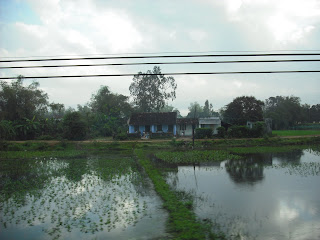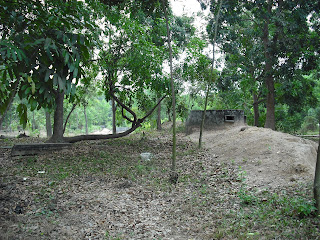 Here's economy section of a jumbo jet.
Here's economy section of a jumbo jet. American Embassy in Saigon. Very new. The old 30-story embassy from which pictures of helicopters on the roof were extracting the last Americans and their friends was torn down soon after Vietnam's reunification.
American Embassy in Saigon. Very new. The old 30-story embassy from which pictures of helicopters on the roof were extracting the last Americans and their friends was torn down soon after Vietnam's reunification. United flight from Hong Kong to Chicago takes 13 hours! You're lucky to have an aisle seat, but they get assigned rather quickly. United's movies leave a lot to be desired and the screen is difficult to see. Many other airlines now have individual viewing screens and more comfortable seats. This was told to me by a lady from Vietnam who was a boat child in 1978 who now practices medicine in Manhattan. I'm not complaining, though. I made it home safe and sound.
United flight from Hong Kong to Chicago takes 13 hours! You're lucky to have an aisle seat, but they get assigned rather quickly. United's movies leave a lot to be desired and the screen is difficult to see. Many other airlines now have individual viewing screens and more comfortable seats. This was told to me by a lady from Vietnam who was a boat child in 1978 who now practices medicine in Manhattan. I'm not complaining, though. I made it home safe and sound. Tennis court in back of Tan Son Nhat Hotel.
Tennis court in back of Tan Son Nhat Hotel. Front of Tan Son Nhat Hotel where I spent my last night @ 33 USD. It had a very good restaurant, too.
Front of Tan Son Nhat Hotel where I spent my last night @ 33 USD. It had a very good restaurant, too.Final thoughts: Vietnam was much better off after we left. Our presence there produced a misanthropic symbiotic relationship. They turned our boys into dopeheads. GI's could buy a pack of 20 cigarettes from which all the tobacco was taken out and replaced with high grade marijuana for one dollar! We turned many of their women into the oldest profession because of poverty and the corrupting influence of American servicemen with a lot of money. When I left the mountain to process home I had to stay at an Army post in Nha Trang. In the evening at the gate of said post, dozens of ladies sought to be picked to be allowed in for the evening. I was very surprised at the spectacle. This blatant debauchery was never reported, but must have gone on at all the large army posts towards the end of the war. We did not do this country any favors.
When the war wound down, all the corruption, guilt, and misguided efforts resulted in low morale in all the branches of the service. I felt unwelcomed when returning, but that did not bother me. I have never worn my service on my sleeve or made it a point to mention I was in Vietnam. I really have no time for anyone who thinks they deserve any special treatment for having served there. All I did was read a lot of books trying to get a handle on how we ever got involved and I took a class on the history of VN at the University of Iowa. My trip was to see how the country was doing after our ruinous expedition. It's doing just fine. Now, with a rejuvenation of perceptions about service in the military, whether warranted or not, when people say, "Thank you for your service," I just say thank you. What I'd like to say is that if I were brave, I would have burned my draft card or gone to Canada or joined with others to end that unfortunate military adventure. Karlie.


















































